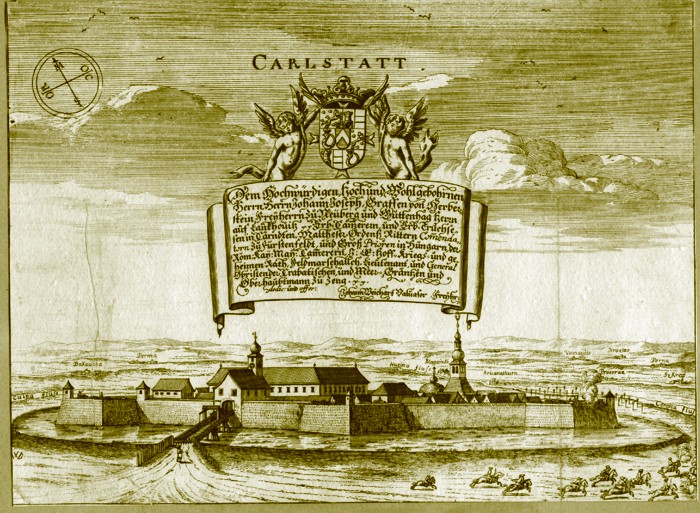Zrínyi IV György was born on 13th April 1549. He was the son of Zrínyi Miklós (Nikola Subic Zrinski), the hero of Szigetvár. Together with Batthyány Boldizsár, Nádasdy Ferenc, and Pálffy Miklós, he fought against the Turks. He was twice captain of Transdanubia (1574-1575; 1582-98) and of Kanizsa Castle (1574-1575; 1582-1590) and also held the title of captain of Légrád.

As the captain of Kanizsa, he did his best to expand the territory of the castle, and he also assigned the villages of Somogy and Baranya to the castle. “I would rather see you all burn to death than not serve me!” – he said to the village judges. As a paternal inheritance, he was appointed royal table master. From 1593 until his death, he also held the office of the Chief Comes of Zala County.

At the beginning of April 1571, he found the beheaded and looted body of Thury György, who had fallen at Orosztony, and buried it in Kanizsa. At the end of the year and the beginning of the following year, he invaded the Turkish territories along the Dráva River as far as Berzence.

The villages were burned and they returned with a large number of prisoners and plunder. Eight years later, in the company of Nádasdy and Batthyány, they carried out a similar act. In the early spring of 1583, they raided the Koppány area to avenge the Turkish attack on the Rába region the previous year. Twice they inflicted heavy defeats on the Bey of Pozsega, at Varasd in 1580 and at Károlyváros four years later.

Zrínyi also fought in the Fifteen Years’ War and played an important role in the victory at Pákozd in 1593. In the spring of 1594, he retook several castles in South Transdanubia, Csurgó, Berzence, and Segesd, and took part in the unsuccessful siege of Esztergom and the battles around Győr. On 30 June 1595, Babócsa was also taken into his hands.

He was then sent to the siege camp of Esztergom. He took part in the recapture of Pápa (1597) and in the campaigns for the liberation of Kanizsa (1600-1601). In 1598 he resigned as captain of Transdanubia and was succeeded by Nádasdy Ferenc. The loss of Kanizsa hit him hard in 1600 when his Muraköz estates became the target of Turkish attacks. Together with Nádasdy and Batthyány Ferenc, he submitted a plan to organize the Borderland against Kanizsa.

He married twice, first to Countess Anna D’Arco of Tyrol and then, in 1577, to Sophie Stubenberg, a member of a distinguished Styrian noble family. He was a vigilant guardian of the family estates, from which even his married daughters received no dowry. He had two sons and three daughters, who he married off into prestigious noble families, the Hungarian Nádasdys, Thurzós, Bánfis, Perényi and the Drugets of Homonna.

He must have been an educated lord, although there is no concrete information about his schools, but the education of his mother (Frangepán Katalin) allows us to assume that she also educated her sons György and Miklós. György was fluent in Hungarian, German, and Croatian, but needed an interpreter for Latin. During his time, the castles of Csáktornya, Ozalj, Brod, Vrbovec, and others were constantly being extended and rebuilt. He invited the printer Rudolf Hoffhalter to his estate, who published works in Croatian dedicated to him and his brother. Thus the Tripartitum (the book of Hungarian laws) was published in Croatian.

Johannes Manlius, a printer, lived on the estate for several years and printed the report of the victory over the Prince of Sásvár in 1587. Franjo Črnko, who was present at the capture of Szigetvár in 1566, wrote the history of the siege at György’s court. The son of the hero of Szigetvár chose the Evangelical religion, but his son, György V. had already returned to Catholicism. His grandsons, Miklós VI, and Péter, further enhanced the family’s reputation.

Photo: Silverije
In 1602 even the Turks wanted him on their side, but the old soldier refused. He was preparing for the next year’s fighting when he died at Vép on 4 May 1603.
Source: Szibler Gábor
Dear Readers, I can only make this content available through small donations or by selling my books or T-shirts:
Please, support me with a coffee here, it is a kind of one-time donation: https://www.buymeacoffee.com/duhoxoxa
or by PayPal here: https://shorturl.at/qrQR5
You can check out my books on Amazon or Draft2Digital, they are available in hardcover, paperback, or ebook:
https://www.amazon.com/dp/198020490X or at https://books2read.com/b/boYd81

My work can also be followed and supported on Patreon: Become a Patron!http://Become a Patron!

Available: https://hungarianottomanwars.myspreadshop.com/

